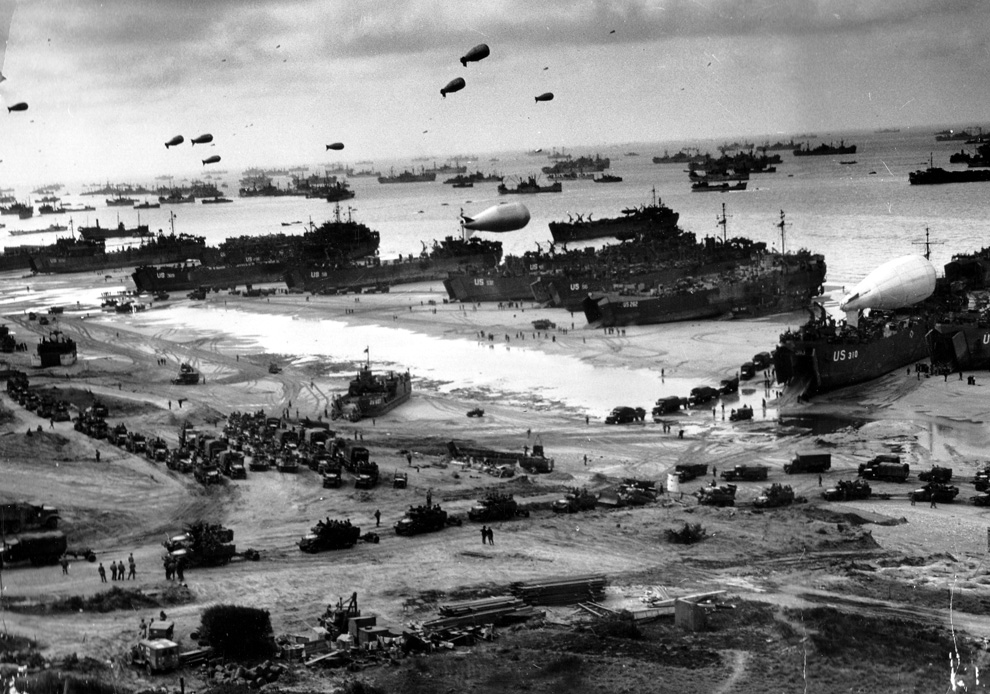“We will accept nothing less than full victory.” – Dwight D. Eisenhower

PHOTO: Boston.com
It was the one of the largest amphibious military assaults in history, requiring extensive planning, involving five beaches, a 50 mile stretch of French coastline, and over 156,000 Allied troops. D-Day, nicknamed “Operation Overload”, was arguably one of the most important battles in WWII. Because of it, by late August in 1944, all of northern France had been liberated from Nazi control, and in the following Spring, the Allies defeated the Germans. It was the beginning of the end, and this is its story.
Preparation
After World War II began, Germany wasted n time in invading and occupying France in 1940. By 1942, the Allies began planning a major invasion, based from Britain, to sail over the English Channel and hit the French beaches. Hitler got wind of these plans and put Erwin Rommel in charge of defending the region. Since they had no idea where the Allies would hit, Rommel built a 2,400 mile long fortification of bunkers, landmines, and beach and water obstacles along the French beaches, called the Atlantic Wall.
Things started to heat up. Plans were made. In January of 1944, General Dwight Eisenhower was made commander of the so-named “Operation Overlord”.
Before Operation Overlord could commence though, another Operation was underway in Normandy, called Operation Bodyguard. It was a huge military deception to mislead the Germans about the date and location of the Allied landings. Allies used fake equipment, double agents, fake radio transmissions meant for Nazi ears, and an entire phantom army commanded by George Patton and supposedly based in England.
The actual date for D-Day was set for June 5, 1944. But, weather would not allow for the crossing of the English channel. The operation was delayed for 24 hours. When Eisenhower’s meteorologist told him conditions would improve the following day, Eisenhower told them to move forward with the assault.
5,000 ships and 11,000 aircraft launched from England later that day, and Operation Overlord began.
June 6, 1944

PHOTO: dday.org
The morning of June 6, the sun rose on thousands of paratroopers and glider troops that had landed behind enemy lines to secure bridges and escape routes and exit roads. At 6:30 AM, on the dot, the British and Canadians took the beaches they’d codenamed Juno, Sword, and Gold, and the Americans took Utah Beach under light opposition from the Germans. The real opposition began at Omaha Beach. Over 2,000 American soldiers died taking it. But, when the gun smoke cleared, and the artillery fire died down, and the day had ended, the 156,000 Allied troops had stormed Normandy’s beaches and won. They’d lost 4,000 men to do it.
In the following week, the Germans were distraught, confused, and lost. Rommel was on vacation, and Hitler didn’t believe a real invasion was happening. He thought it was a distraction from an attack north of the Seine, and would not authorize reinforcements to help defend Normandy and France. Allied air support rained down on France, taking out bridges and crippling the German mobilization, and the Allied naval suppored ushered in more Allied troops to the area.
By June 11, the beaches were fully secured, and the Allies had successfully llanded 50,000 vehicles, 100,000 tons of equipment, and 326,000 troops at Normandy. They fought their way across the French countryside, through rough terrain and intense German opposition. But, by the end of June, they seized more and more vital ports and were able to land reinforcements to support their invasion and liberation of France.
Victory
The Allies reached the Seine by the end of August of 1944. They liberated Paris and completely uprooted the German occupation of France. From France, they launched their invasion of Germany in perfect sync with Soviet troops closing in on the country from the east.
D-Day was the day that made victory against the Nazis possible. It was a crippling blow to Nazi Germany and to Hitler and Rommel’s forces. It allowed the Allies to skewer Germany on two sides, and prevented Hitler from reinforcing his Eastern front against the Soviet army.
On May 8, 1945, Nazi Germany surrendered. World War II was, officially, coming to an end, and the world breathed a collective sigh of relief.

